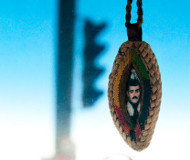6/3/2013
Oregon: Jesus Malverde Medallion Did Not Justify Traffic StopCourt chides police officer for searching a pair of Mexican motorists who had a Jesus Malverde medallion and two cell phones.

The Oregon Court of Appeals on Thursday rejected the argument that an image of Jesus Malverde in an automobile is suspicious enough to warrant a search for drugs. A three-judge panel rejected the justification Oregon State Police Trooper Wells provided after pulling over a Toyota 4Runner on Interstate 5. When Trooper Wells came to the window to ask Manuel Meza-Garcia for his license and registration, the trooper's suspicion was heightened after he noticed something near the windshield.
"There was also the mention of the necklace hanging from the mirror, rear view mirror, that Trooper Wells stated he recognized as that of the Saint Jesus Malverde, which he stated in his training and experience is often associated with narcotics trafficking," Douglas County Circuit Court Judge Frances Elaine Burge explained. "And again that alone would not be sufficient to raise reasonable suspicion."
Jesus Malverde is not a Catholic saint. Rather, he was a bandit who shot in 1909 in Sinaloa, Mexico, according to legend, while robbing from the rich to give to the poor. The Robin Hood-style myth that surrounds Malverde has made him something of a patron saint for drug dealers. The appellate judges refused to consider the medallion as evidence and instead rejected the other assertions police used to search Meza-Garcia. The trooper insisted it was inherently suspicious to have two people driving with two cell phones north on I-5 without visible luggage. The appellate judges rejected this reasoning.
"As an initial matter, the fact that the vehicle contained two occupants and two cell phones has no bearing on reasonable suspicion," Judge Timothy J. Sercombe wrote. "Wells testified at the suppression hearing that those facts were significant to him because, in his 'limited experience,' drug traffickers will generally use two people to transport drugs in vehicles and 'there will be multiple cell phones in a vehicle.' Wells admitted, however, that he had 'seen seizures that had as many as seven people in a vehicle and as little as one person in a vehicle' and that observing multiple people with personal cell phones is common. Put frankly, the presence of two persons and two cell phones in a vehicle is wholly unremarkable."
The judges also rejected nervousness, driving without visible luggage and the scent of an air freshener as evidence of wrongdoing.
"Considered in their totality, they simply do not give rise to a reasonable suspicion that defendant was engaged in drug-related criminal activity," Judge Sercombe wrote. "Accordingly, Wells's stop of defendant was unlawful."
The appeals court did not throw out the conviction, since both suspects signed a written consent form that contained clear instructions in both Spanish and English regarding the right to refuse the search. Once he had permission, the trooper found methamphetamine stashed behind a speaker.
A copy of the decision is available in a 50k PDF file at the source link below.


